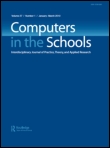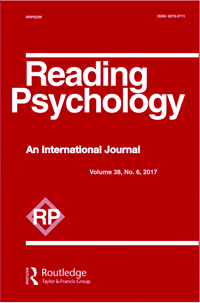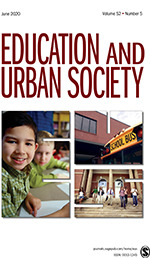Dr. Rachel Schechter’s research on educational technology is featured in peer-reviewed academic literature. Additional articles published under Rachel’s tenure as lead of the research team at Lexia from 2013-2019 are available here. To view Rachel’s articles for teachers and learning designers, choose from the menu.
Exploration of a Blended Learning Approach to Reading Instruction for Low SES Students in Early Elementary Grades
Rachel Schechter, Paul Macaruso, Elizabeth R. Kazakoff & Elizabeth Brooke
This study investigated the potential benefits of a blended learning approach on the reading skills of low socioeconomic status students in Grades 1 and 2. Treatment students received English language arts instruction that was both teacher-led and technology-based. Comparisons were made with control students who received the same English language arts instruction without the blended learning component. Results showed significantly greater pretest/posttest gains on a standardized reading assessment for the treatment students compared to the control students. The greatest discrepancy occurred in reading comprehension. A sub-analysis of low-performing English language learner students in the treatment group revealed the largest reading gains. At posttest, these students performed at the level of non-English language learner students in the control group. Results indicated a blended learning approach can be effective in enhancing the reading skills of low socioeconomic students.
Exploring the Impact of Engaged Teachers on Implementation Fidelity and Reading Skill Gains in a Blended Learning Reading Program
Rachel L. Schechter, Elizabeth R. Kazakoff, Kristine Bundschuh, Jen Elise Prescott & Paul Macaruso
The number of K–12 classrooms adopting blended learning models is rapidly increasing and represents a cultural shift in teaching and learning; however, fidelity of implementation of these new blended learning programs varies widely. This study aimed to examine the role of teacher engagement in student motivation and achievement in a blended learning environment. Reading skill data were analyzed from 19,366 students across 624 schools led by teachers defined as engaged users of a blended learning reading program (Lexia Reading Core5 [Core5]). Results showed significant improvements in reading skills during the analyzed period for the students of the engaged teachers in comparison to neighboring classrooms (171,850 students in the same 624 schools) of less engaged teachers.
Paul Macaruso, Shani Wilkes, Sarah Franzén & Rachel Schechter
This three-year longitudinal study tracked the reading performance of 68 kindergarten students from low SES backgrounds. These students received instruction with a blended learning program ——Lexia® Core5® Reading—from the start of kindergarten through second grade. During each school year the students made significant gains on a standardized reading test. However, performance on the test declined significantly from the spring of one school year to the fall of the next, indicative of a substantial summer slide. Yet, further comparisons revealed that performance from the fall of one school year to the fall of the next showed significant improvement, pointing to the benefits of school-based instruction to help overcome the summer slide. More than 90% of low performers who started kindergarten scoring below average on the standardized test finished second grade scoring average or better. Benefits of Lexia Core5® Reading to support reading growth in elementary school students from low SES backgrounds are discussed.
Fostering Engagement in Educational Technologies Through Developmental Theory and Program Data
Elizabeth R. Kazakoff, Melissa Orkin, Kristine Bundschuh & Rachel L. Schechter
This chapter provides theoretical and practical insights for integrating and improving motivation in the design of educational technologies and enhancement of student engagement. While the number of new products available to support differentiated learning is great news for students, the rapid development of products may mean quantity over quality. Schools may end up purchasing educational technology tools that may not necessarily be user-friendly, developmentally appropriate, or built with the student end-user in mind, especially for elementary school students. Ideas from popular and well research motivational theories—self-determination theory, attribution theory, and goal orientation theory/mindsets—are discussed in terms of their integration in the design of educational technologies. The blended learning literacy program, Lexia Reading Core5® (Core5), is used as an example of how to iteratively redesign educational technologies taking motivational theories into account. The specific theories and examples presented are then summarized as for practical application.
Can educational technology effectively differentiate instruction for reader profiles?
Lauren S. Baron, Tiffany P. Hogan, Rachel L. Schechter, Pamela E. Hook & Elizabeth C. Brooke
Teachers are responsible for identifying and instructing an increasingly diverse population of student readers. Advances in educational technology may facilitate differentiated instruction. Using data from a large, population-based sample of third-grade students, we investigated what works for whom in technology-based literacy instruction. We classified 594 students into four reader subgroups or profiles based on two scores from a readily-available, commonly-used progress monitoring tool (aimsweb©). Using this simple and accessible method, we identified profiles of readers that resemble the poor decoder, poor comprehender, mixed deficit, and typical reader subgroups found in past studies that used extensive test batteries or advanced statistics. We then employed nonparametric analyses to examine both proximal and distal outcomes across one academic year. First, we compared the relative progress of reader profiles on a technology-based reading program (Lexia® Core5® Reading). Second, we determined whether each reader profile made gains on aimsweb at the end of the year. We found that Core5 effectively differentiated online instruction and contributed to improved aimsweb performance for most reader profiles. The findings from this study help inform educational best practices for efficient identification of and effective intervention for all students.

Preschoolers’ Recall of Science Content From Educational Videos Presented With and Without Songs
Rachel L. Schechter, Tufts University, United States
This experimental investigation evaluated the impact of educational songs on a child’s ability to recall scientific content from an educational television program. Preschoolers’ comprehension of the educational content was examined by measuring children’s ability to recall the featured science content (the function of a pulley and its parts) and their use of the precise scientific terms presented in the episode. A total of 91 preschoolers were included (3-5 years old). Clusters of children were randomly assigned to a control group or one of three video groups: (a) Dialogue Only, which did not include a song; (b) Dialogue Plus Lyrics, which included a song; or (c) Lyrics Only, which consisted of a song, played twice. Results from interviews suggested that children from all video groups (lyrics and/or dialogue) were able to explain the form and function of a pulley better than the control group. The data suggested that children from the Lyrics Only group understood the science content because of the visual imagery, not through the information provided in the lyrics. In terms of precise vocabulary terms, significantly more children in the Dialogue Only group recalled at least one precise term from the program compared to the Lyrics Only group. Looking at the interview as a whole, the children’s responses suggested different levels of scientific understanding. Children would require additional teacher-led instruction to deepen their scientific understanding and to clarify any misconceptions. This paper discusses implications of these findings for teachers using multi-media tools in the science classroom and producers creating new educational programming for television and other platforms.
Fostering Resilience Among Youth in Inner City Community Arts Centers: The Case of the Artists Collective • 2012 • Education and Urban Society
Alison M. Rhodes, Rachel Schechter
Growing up in an inner city environment can inhibit healthy development and have detrimental consequences for children and adolescents such as increased risks for many social and psychological problems. This article explores the role of community arts centers in fostering resilience among youth living in the inner city. A review of the literature of risk factors associated with growing up in an inner city environment provides a rationale for the need for interventions that promote resilience by creating a refuge from the surrounding poverty and violence, and which strengthen youth’s personal and social resources. We examine the case of the Artists Collective, an inner city community arts center in Hartford, Connecticut, and propose that there are three components of community arts centers that contribute to youths’ resilience. First, features of the physical space promote resilience. Second, they are a place where prosocial relationships and social capital contributing to resilient functioning can be formed. Finally, we hypothesize that learning about and participating in the arts fosters resilience through the development of person-level protective factors such as self-efficacy, improved emotional regulation, social skills, coping skills, and ethnic pride.
![]()




